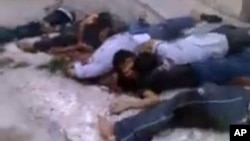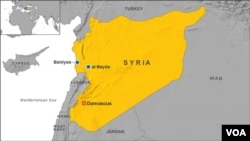BEIRUT —
Atrocities and massacres have been regular occurrences in Syria’s two-and-half year civil war, but Human Rights Watch provided details Friday about one of the worst massacres carried out by forces loyal to President Bashar al-Assad.
The Human Rights Watch (HRW) report documents in exacting detail the summary executions of 248 people by Syrian government forces and allied irregular units in the mainly Sunni Muslim towns of al-Bayda and Baniyas on May 2 and 3 this year. The dead included women and children, some of them infants.
Shortly after the summary executions took place, the Syrian government acknowledged that its forces had been active in the towns—Sunni enclaves in a region overwhelmingly populated by pro-Assad Alawite Muslims—but insisted they had been battling “terrorists.”
Syrian government officials denied that its forces had carried out a massacre of unarmed civilians, but Ali Haidar, minister of state for national reconciliation affairs, later told the Wall Street Journal that “mistakes” may have been made and that a government committee was investigating.
Based on eyewitness testimony of survivors who saw or heard government and pro-government forces detain and then execute their relatives, the 68-page HRW report suggests the majority of those killed, generally by three bullets to the head, were non-combatants executed several hours after firefights between the army and rebels had ended.
According to the survivors, government forces started to ransack and loot houses early in the afternoon, and then rounded up the men, separating them from the women and children. The men were either shot on the spot or moved to the main square and shot there. The bodies were later moved to a mobile phone store where they were partially burned, the HRW report said.
Surviving relatives describe killings
Among the dead were the four grown sons of 70-year-old Mustafa Suweid. Samira, the wife of one of the sons, said the four were forced into a next-door apartment along with a neighbor.
“Suddenly we heard gunshots. I started screaming to my father-in-law,” Samira told the HRW investigators. “I ran to the window and saw around 20 soldiers leave the apartment.”
“I first saw my husband’s body by the door,” Samira continued. “The remaining three were in a room on top of each other. Each of the men had three bullets in him. Ahmad was not yet dead. But we were unable to get him to a hospital. He died two hours later. We moved the bodies into one room and covered them. The blood slowly seeped onto the carpet.”
Nearby, soldiers entered the home of the Bayasi family, the HRW report said. According to three local residents, all the family members—nine men, three women, and 14 children—were executed with the exception of a three-year old girl who they said was wounded but survived.
A local resident, Majed, who was among the first to discover the corpses also shared his grisly story with HRW.
“I was busy helping the surviving residents leave the town when the fiancé of one of the Bayasi women asked me to go with him to check on her," he said. "We saw no one in the first room. As we entered further into the house, we got to a room where we found so many corpses. Mothers and children piled on top of each other. One mother was still covering her son. I thought he may have survived, but as I turned her over, I saw that he had been also shot. My friend’s fiancé was also killed. We closed the windows of the house because we did not want any wild animals to come in.”
The HRW report also detailed a separate incident in which the wife of a man called Muhammad Shaker said she found her husband with bullet wounds to his head and shoulder.
“Half of his head…was all smashed up. His insides were all out,” she told HRW. “This [the injuries to his abdomen] was done with cleavers.”
Cell phone video
The Human Rights Watch report includes cell phone video recordings made by survivors to support much of the testimony gathered by HRW. Some images of the dead – although only of dead men – also were shown the following days on Syrian state television. The dead men were said to be “terrorists.”
HRW investigators also spoke to survivors who discovered the bodies in the cell phone store in al-Bayda.
“What we saw inside it [the store] I cannot describe,” said Mohammad, an opposition activist. “The room was four meters by four meters. There were more than 60 dead bodies there. They were all next to each other and all burnt. The smoke was still coming out of them.”
According to HRW, similar summary executions took place in Baniyas, 10 kilometers from al-Bayda, where local residents named 30 men, 22 women, and 29 children who had been executed.
Conventional weapons used
“While the world’s attention is on ensuring that Syria’s government can no longer use chemical weapons against its population, we shouldn’t forget that Syrian government forces have used conventional means to slaughter civilians,” says Joe Stork, HRW’s acting Middle East director.
Why al-Bayda and Baniyas were earmarked for such treatment isn’t clear, but some opposition activists say the executions were meant to encourage Sunni Muslims to leave the region.
Both sides in Syria’s increasingly sectarian conflict, though, have committed atrocities.
Earlier this week, the United Nations commission charged with investigating human rights violations in Syria released an updated version of its findings listing a number of violations committed by both the rebels and Assad government forces.
“Government and pro-government forces have continued to conduct widespread attacks on the civilian population, committing murder, torture, rape and enforced disappearance,” the commission said. "They have laid siege to neighborhoods and subjected them to indiscriminate shelling."
But the commission also noted that Syrian rebels “have committed war crimes, including murder, execution without due process, torture, hostage taking.”
The commission said the Syrian government was responsible for eight massacres since the beginning of the year, while the rebels were responsible for one.
The Human Rights Watch (HRW) report documents in exacting detail the summary executions of 248 people by Syrian government forces and allied irregular units in the mainly Sunni Muslim towns of al-Bayda and Baniyas on May 2 and 3 this year. The dead included women and children, some of them infants.
Shortly after the summary executions took place, the Syrian government acknowledged that its forces had been active in the towns—Sunni enclaves in a region overwhelmingly populated by pro-Assad Alawite Muslims—but insisted they had been battling “terrorists.”
Syrian government officials denied that its forces had carried out a massacre of unarmed civilians, but Ali Haidar, minister of state for national reconciliation affairs, later told the Wall Street Journal that “mistakes” may have been made and that a government committee was investigating.
Based on eyewitness testimony of survivors who saw or heard government and pro-government forces detain and then execute their relatives, the 68-page HRW report suggests the majority of those killed, generally by three bullets to the head, were non-combatants executed several hours after firefights between the army and rebels had ended.
According to the survivors, government forces started to ransack and loot houses early in the afternoon, and then rounded up the men, separating them from the women and children. The men were either shot on the spot or moved to the main square and shot there. The bodies were later moved to a mobile phone store where they were partially burned, the HRW report said.
Surviving relatives describe killings
Among the dead were the four grown sons of 70-year-old Mustafa Suweid. Samira, the wife of one of the sons, said the four were forced into a next-door apartment along with a neighbor.
“Suddenly we heard gunshots. I started screaming to my father-in-law,” Samira told the HRW investigators. “I ran to the window and saw around 20 soldiers leave the apartment.”
“I first saw my husband’s body by the door,” Samira continued. “The remaining three were in a room on top of each other. Each of the men had three bullets in him. Ahmad was not yet dead. But we were unable to get him to a hospital. He died two hours later. We moved the bodies into one room and covered them. The blood slowly seeped onto the carpet.”
Nearby, soldiers entered the home of the Bayasi family, the HRW report said. According to three local residents, all the family members—nine men, three women, and 14 children—were executed with the exception of a three-year old girl who they said was wounded but survived.
A local resident, Majed, who was among the first to discover the corpses also shared his grisly story with HRW.
“I was busy helping the surviving residents leave the town when the fiancé of one of the Bayasi women asked me to go with him to check on her," he said. "We saw no one in the first room. As we entered further into the house, we got to a room where we found so many corpses. Mothers and children piled on top of each other. One mother was still covering her son. I thought he may have survived, but as I turned her over, I saw that he had been also shot. My friend’s fiancé was also killed. We closed the windows of the house because we did not want any wild animals to come in.”
The HRW report also detailed a separate incident in which the wife of a man called Muhammad Shaker said she found her husband with bullet wounds to his head and shoulder.
“Half of his head…was all smashed up. His insides were all out,” she told HRW. “This [the injuries to his abdomen] was done with cleavers.”
Cell phone video
The Human Rights Watch report includes cell phone video recordings made by survivors to support much of the testimony gathered by HRW. Some images of the dead – although only of dead men – also were shown the following days on Syrian state television. The dead men were said to be “terrorists.”
HRW investigators also spoke to survivors who discovered the bodies in the cell phone store in al-Bayda.
“What we saw inside it [the store] I cannot describe,” said Mohammad, an opposition activist. “The room was four meters by four meters. There were more than 60 dead bodies there. They were all next to each other and all burnt. The smoke was still coming out of them.”
According to HRW, similar summary executions took place in Baniyas, 10 kilometers from al-Bayda, where local residents named 30 men, 22 women, and 29 children who had been executed.
Conventional weapons used
“While the world’s attention is on ensuring that Syria’s government can no longer use chemical weapons against its population, we shouldn’t forget that Syrian government forces have used conventional means to slaughter civilians,” says Joe Stork, HRW’s acting Middle East director.
Why al-Bayda and Baniyas were earmarked for such treatment isn’t clear, but some opposition activists say the executions were meant to encourage Sunni Muslims to leave the region.
Both sides in Syria’s increasingly sectarian conflict, though, have committed atrocities.
Earlier this week, the United Nations commission charged with investigating human rights violations in Syria released an updated version of its findings listing a number of violations committed by both the rebels and Assad government forces.
“Government and pro-government forces have continued to conduct widespread attacks on the civilian population, committing murder, torture, rape and enforced disappearance,” the commission said. "They have laid siege to neighborhoods and subjected them to indiscriminate shelling."
But the commission also noted that Syrian rebels “have committed war crimes, including murder, execution without due process, torture, hostage taking.”
The commission said the Syrian government was responsible for eight massacres since the beginning of the year, while the rebels were responsible for one.












